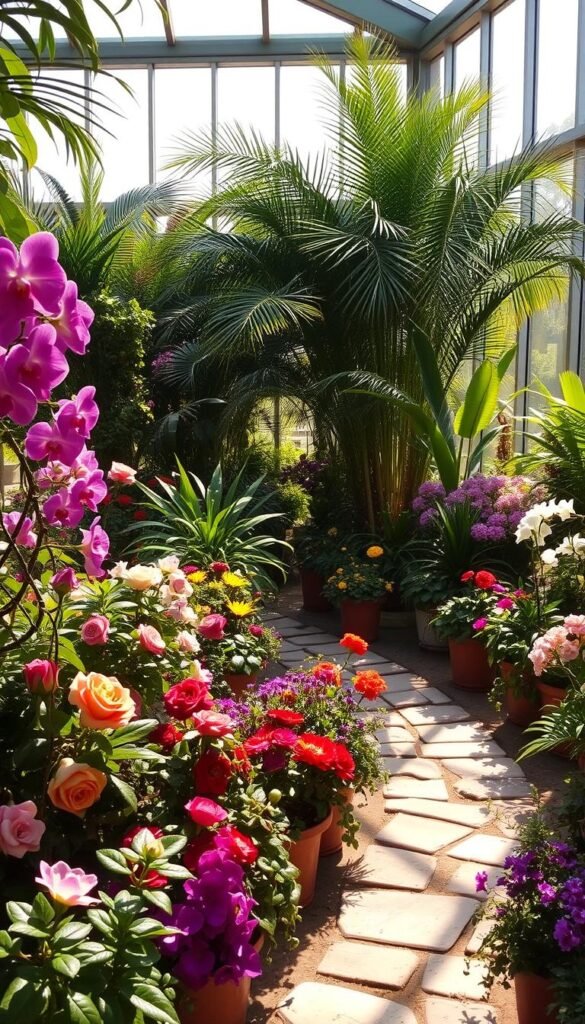Imagine brightening your home with nature’s artistry every day. Tropical plants that burst into colorful blooms can turn any room into a lively retreat. These green companions thrive indoors, offering year-round beauty even when snow blankets the ground outside.
You don’t need a green thumb to succeed. Most flowering varieties crave simple care: indirect sunlight, occasional watering, and well-draining soil. Place them near east-facing windows, and they’ll reward you with petals that pop against their glossy leaves.
Beyond their visual charm, these plants work quietly to clean your air. Studies show they filter toxins while boosting creativity and relaxation. Picture reading near a flamingo lily’s heart-shaped flowers or hosting friends beside a cascade of orchids.
Whether you’re in a studio apartment or a suburban house, there’s a perfect match for your space. From low-maintenance peace lilies to eye-catching begonias, you’ll find options for every skill level. Ready to start your own slice of paradise?
Understanding the Benefits of an Indoor Flower Garden
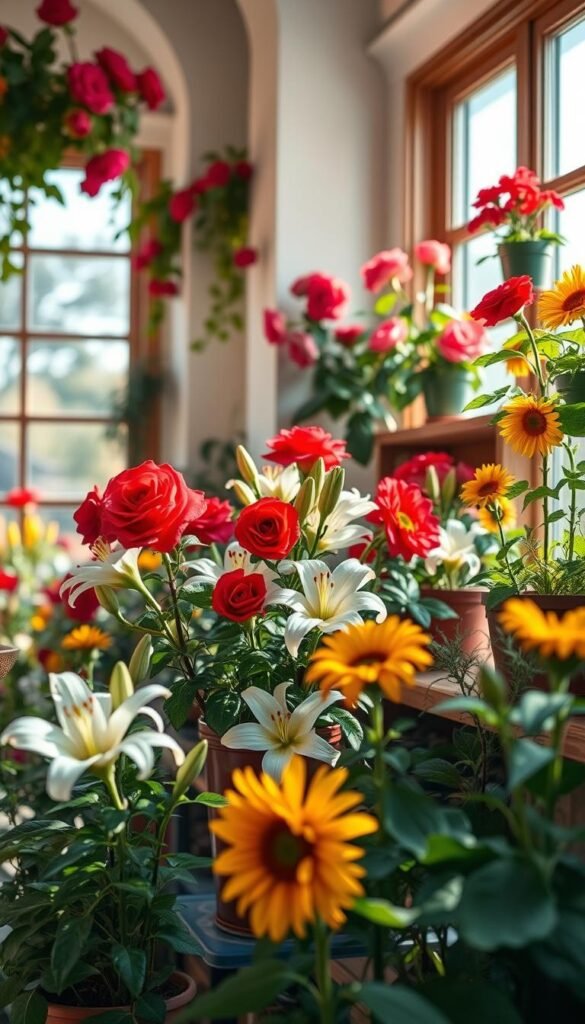
Transform your home into a sanctuary with living decor that thrives in any season. Species like peace lilies and orchids deliver lush greenery even when their blossoms fade, while geraniums and roses surprise you with vivid color displays. These natural wonders do more than please the eye—they actively enhance your daily life.
Why Choose Indoor Blooms?
Plants brighten your surroundings in two ways: through enduring foliage and periodic floral shows. Research from NASA reveals many flowering varieties filter airborne toxins like formaldehyde. One study found rooms with flowers reduced stress by 35% compared to spaces without them.
Health and Aesthetic Perks
Beyond clean air, these plants boost mental clarity. Their evolving beauty creates focal points that spark joy—no weekly bouquet purchases needed. A single $20 orchid can bloom for months, while cut arrangements cost $15-$50 each week.
| Benefit Type | Key Advantage | Example Plants |
|---|---|---|
| Air Quality | Removes 60% of toxins | Peace Lily, Geranium |
| Mood Enhancement | Lowers stress hormones | Orchid, Jasmine |
| Cost Efficiency | Lasts 6x longer than cut stems | Rose, Lipstick Plant |
Easy care routines make these natural companions ideal for busy lifestyles. Water most varieties weekly and provide indirect light—they’ll handle the rest while transforming your space.
Essential Lighting and Environmental Conditions
Creating thriving displays starts with understanding your space’s light patterns. Most tropical species flourish near windows but need protection from harsh rays. Position them where sunlight feels warm but never scorching—like morning rays through east-facing glass.
Bright Indirect Light vs. Direct Sunlight
Bright indirect light works like a soft spotlight. It bathes leaves in energy without causing fade or burn. Achieve this by placing plants 3-5 feet from south-facing windows or using sheer curtains as filters.
Some species crave stronger rays. Desert roses and crown of thorns demand 4-6 hours of direct sunlight daily. Rotate these sun-lovers weekly for even growth.
| Light Type | Best Locations | Plant Examples |
|---|---|---|
| Bright Indirect | East/West windows | Orchids, Peace Lilies |
| Direct Sun | South-facing sills | Cacti, Succulents |
Maintaining the Right Temperature and Humidity
Keep thermostats between 65-75°F—ideal for most bloomers. Avoid drafts from vents or doors. For humidity, try these simple tricks:
- Group plants together
- Use pebble trays with water
- Mist leaves weekly
Winter brings challenges. Shorter days may require grow lights to maintain 12-14 hours of bright light. LED options mimic natural conditions without overheating leaves.
Choosing the Best Indoor Blooming Plants

Picking the perfect flowering companions starts with smart selection strategies. Look for specimens bursting with unopened buds rather than full blooms. These young plants promise weeks of unfolding beauty, giving you front-row seats to nature’s daily magic show.
Flip leaves gently during inspection. Healthy plants show firm stems and pest-free foliage. Avoid any with yellowing edges or sticky residue—red flags for future problems. Remember: a robust root system matters more than temporary floral fireworks.
Match your home’s personality with the right variety. Consider these factors:
| Light Needs | Care Level | Top Picks |
|---|---|---|
| Low light | Easy | Peace Lily, African Violet |
| Bright indirect | Moderate | Orchid, Lipstick Plant |
| Direct sun | Expert | Crown of Thorns, Desert Rose |
New arrivals need a 2-week quarantine. This simple step protects your existing indoor plants from hidden pests. Use this time to observe growth patterns and adjust watering habits.
Start with forgiving options like holiday cacti. Their flexible nature helps build confidence while delivering stunning seasonal displays. As skills grow, experiment with temperamental varieties that reward patience with extraordinary flowering shows.
Plant Spotlight: Chrysanthemums and Their Colorful Charm
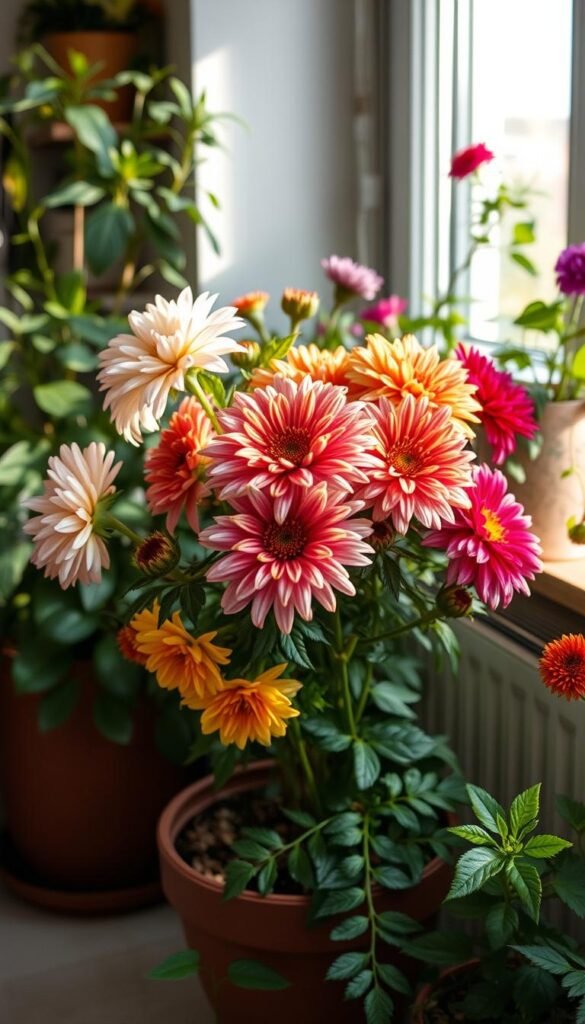
When autumn’s palette paints the world outside, chrysanthemums bring that warmth indoors. These seasonal stars explode with shades ranging from burnt orange to royal purple, turning any corner into a cozy retreat.
Spring planting gives mums the best start. Choose pots with drainage holes and position them where bright light floods the space all day. A south-facing windowsill works perfectly if you rotate the pot weekly for even growth.
Secrets to Success With Mums
These plants thrive on simplicity. Keep soil consistently moist but never soggy—water when the top inch feels dry. Pair this routine with good air flow to prevent mildew.
| Care Factor | Requirement | Pro Tip |
|---|---|---|
| Light | 6+ hours daily | Use sheer curtains at noon |
| Water | Weekly | Check soil with finger test |
| Blooms | 3-4 weeks | Remove spent flowers promptly |
While indoor reblooming is tricky, it’s not impossible. After the first flowers fade, trim stems back by half. Feed monthly with balanced fertilizer and watch for new buds.
Safety first: These beauties contain natural compounds that upset pet stomachs. Keep them on high shelves or in rooms your furry friends can’t access. With minimal effort, you’ll enjoy weeks of fiery blooms that outshine any pumpkin spice decor.
Plant Spotlight: The Vibrant Lipstick Plant
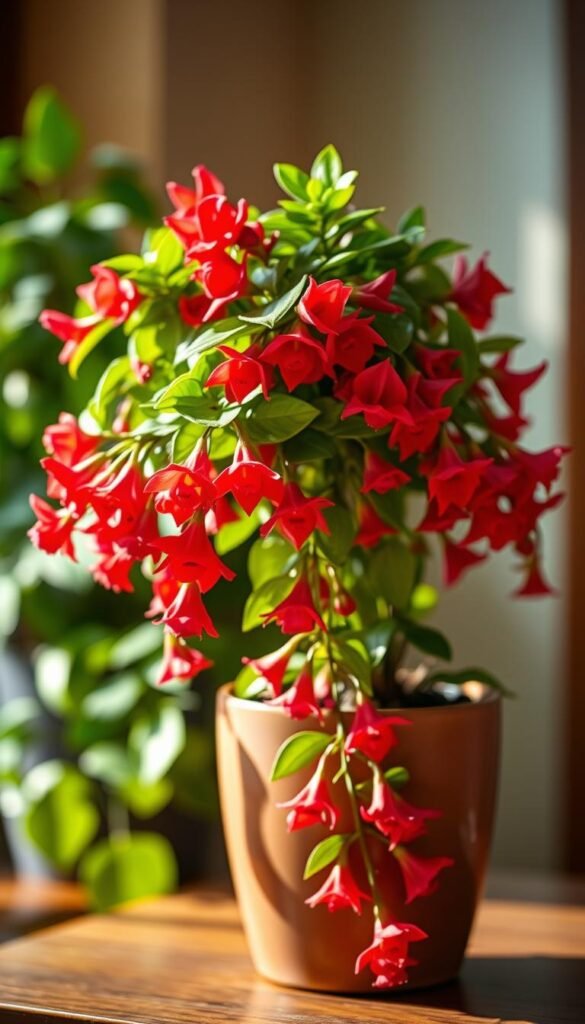
Draping vines burst with crimson tubes that look freshly plucked from a makeup bag—welcome to the world of lipstick plants. Named for their iconic floral shape, these tropical beauties produce blooms resembling miniature cosmetic wonders. With proper care, their fiery red flowers can dazzle your space any time of year, though spring and summer bring the most spectacular shows.
Optimizing Soil and Light Conditions
This plant thrives in airy, well-draining soil. Mix orchid bark with perlite and peat moss to create a blend that keeps roots happy without waterlogging. Let the topsoil dry slightly between waterings—overly damp conditions invite root rot.
Bright filtered light fuels those signature blooms. Position your lipstick plant near an east-facing window where morning sun gently bathes its leaves. If sunlight feels too intense, diffuse it with sheer curtains. Rotate the pot weekly for balanced growth.
Consistent warmth (65-80°F) and humidity keep this tropical native flourishing. Group it with other moisture-loving varieties or place a pebble tray nearby. You’ll soon witness cascading stems adorned with tubular flowers that outlast store-bought bouquets.
Best of all? This stunner is completely pet-safe. Cats and dogs can coexist safely with its trailing vines, letting you enjoy nature’s artistry worry-free.
Plant Spotlight: Jasmine’s Fragrance and Elegance
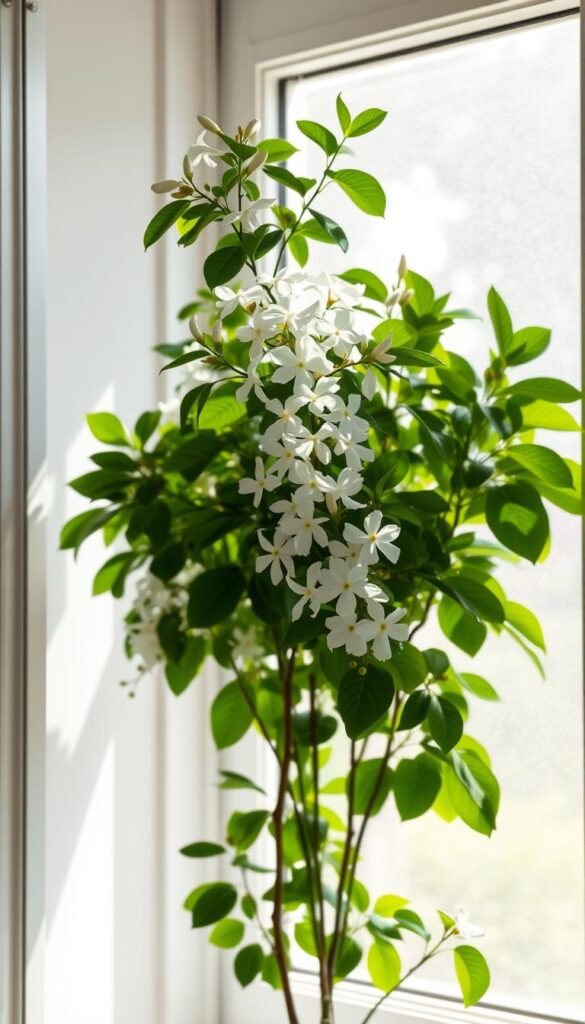
Let your home breathe with the timeless allure of nature’s perfume. Jasmine’s white flowers release an intoxicating scent that transforms rooms into fragrant sanctuaries. Unlike air fresheners, this living plant offers pure aromatherapy—its sweet notes reduce anxiety while uplifting moods naturally.
The classic variety stuns with snow-white petals against glossy green leaves, creating striking contrast for modern interiors. Place it where sunlight dances through windowpanes—south or west-facing spots work best. With 4-6 hours of daily light, you’ll witness buds unfurling like starbursts throughout different times year.
Choose blooming schedules to match your lifestyle:
- Winter jasmine brightens chilly months
- Arabian types perfume summer nights
- Pink-flowered varieties add soft hues in spring
Pet owners rejoice—every part of this elegant plant stays harmless to curious paws. Water when soil feels dry an inch down, and watch those waxy leaves gleam. Whether you crave year-round blossoms or seasonal highlights, jasmine adapts while keeping your space safe and scented.
Plant Spotlight: Gloxinia for a Show-Stopping Display
For those craving a living masterpiece, gloxinia delivers nature’s fireworks in potted form. Its flowers erupt in shades ranging from cotton-white to ruby-red, often with speckled throats that demand a second look. Each trumpet-shaped bloom stretches up to 4 inches wide—nature’s own living room centerpiece.
The plant stuns even when not flowering. Velvety leaves form lush rosettes, their deep green surfaces contrasting beautifully with vivid petals. This dual appeal makes gloxinias ideal for tabletops or shelves where texture matters as much as color.
Your efforts pay off for months. From late spring through summer, new buds emerge like clockwork. Keep soil evenly moist and provide bright, filtered light—east-facing windows work magic. Avoid wetting the foliage to maintain those signature fuzzy leaves.
Best of all? These tropical beauties play nice with pets. Place them anywhere without worrying about curious cats or dogs. With minimal care, you’ll enjoy a rotating gallery of floral artistry that puts cut arrangements to shame.

